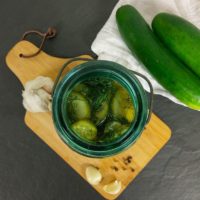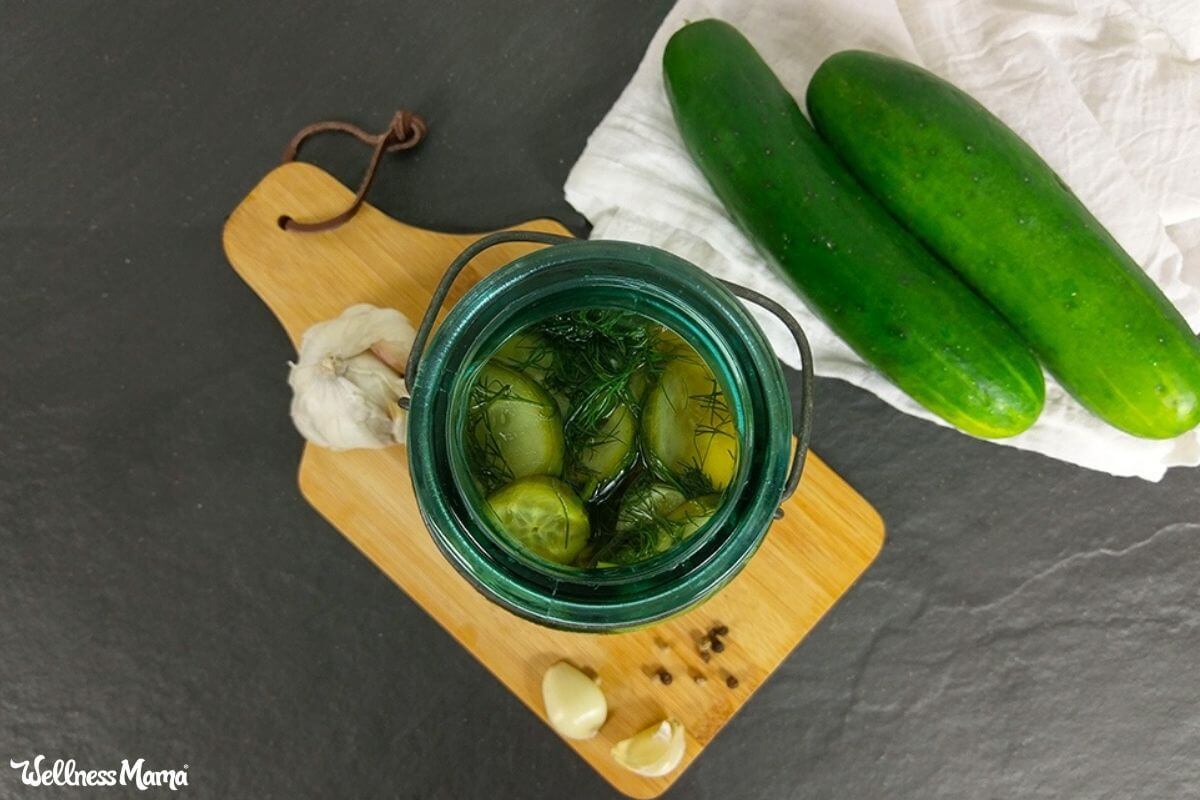Pickles are one of the items that I always have in my naturally stocked fridge. I learned how to pickle cucumbers because I wanted to avoid the less than ideal ingredients found in most store-bought pickles. Not only are homemade pickles healthier, but they taste great!
Why Pickle Cucumbers?
Aside from the fact they’re a delicious way to preserve fresh cucumbers, the short answer is so they contain just crunchy cucumber goodness… and nothing else!
Store-bought pickles often contain yellow food dyes that have been linked with certain cancers and behavioral problems. Definitely not something I’m looking for in a pickle! There are several different ways to pickle cucumbers, and it depends on what I’m in the mood for (and have time for).
Also, if you make pickles with the traditional fermenting method, you will add healthy probiotics to your diet!
Two Cucumber Pickling Methods
When you’re ready to make homemade pickles, you can take one of two approaches:
Quick Refrigerator Pickles (With Vinegar)
Vinegar is the most popular and common way to pickle cucumbers. Regular white vinegar is an economical option that allows other herbs and flavors in the pickled cucumbers to shine through. Red wine vinegar and even apple cider vinegar can also be used if desired. The leftover vinegar brine from a previous batch of pickles is another, even more frugal option.
Traditional Fermented Pickles (No Vinegar)
Naturally fermented pickles are the traditional way to pickle cucumbers. This simple method uses salt, water, and natural bacteria from the air to get a tangy, fermented pickle. Fermented pickles also have some added health benefits since the method “unlocks” the nutrition in the cucumbers and adds healthy probiotics to your diet. Learn all about how to start fermenting here.
What You Need to Make Homemade Pickles
A quick batch of refrigerator pickles is an easy option on a busy day. You will need:
- cucumbers
- dill
- garlic
- onion
- vinegar (if not fermenting)
- sugar (or sweetener of some kind)
- water
- salt
It really depends on the recipe and which flavor I’m going for, but quick pickles are forgiving when it comes to exact ratios (unless canning is involved). Usually recipes for how to pickle cucumbers call for pickling or canning salt, not iodized or table salt. However, sea salt will also work and is a healthier option.
For fermented pickles you just need salt, water, and cucumbers! Of a little garlic and dill never hurt either 🙂
1) Select the Right Cucumbers
Certain varieties hold up better in the pickling brine. Kirby cucumbers are a popular choice. Long, thin-skinned cucumbers, like English cucumbers, don’t work well. Store-bought cucumbers are usually coated in wax, so buying locally or homegrown is the best option.
Overripe or wimpy cucumbers make for mushy pickles, even if they’re just barely past their prime. According to Bon Appetit, the best cucumbers are:
- 4-5 inches in length
- Firm
- Fresh (not overripe or underripe)
- Have a thick skin (which makes for a crunchier pickle)
2) Gather Spices
Garlic, dried or fresh dill, whole mustard seeds, peppercorns, onions, or even red pepper flakes are optional add-ins that make your pickles more zesty or sweet, as desired.
When in doubt, choose fresh ingredients for more flavor, although dried will also work.
For sweet pickles, I use honey instead of processed sugar. This does add a stronger flavor to the pickles, but I think it’s equally delicious (and much healthier). For those who do want a more typically flavored sweet pickle, organic cane sugar is still a step better (though not ideal) than the heavily refined sugar found in store-bought pickles.
3) Prep for Crisp Pickles
- Cut the top off (where the stem attached to the cucumber). The blossom end contains enzymes that make for soggy pickles.
- Add a few grape or oak leaves. The tannins from the leaf are an astringent that helps pickles stay firmer.
- Choose cucumbers that aren’t too old and are very firm.
- Soak cucumbers for 30 minutes in an ice bath and drain before using for pickles.

How to Pickle Cucumbers (Quick Method)
Servings
Ingredients
- ¾ cup white vinegar
- 3 cloves garlic (smashed)
- ¾ cup filtered water
- 1 TBSP sea salt (or Himalayan salt)
- ½ cup honey (optional)
- 2 heads fresh dill (or 3 TBSP fresh leaves, or 2 TBSP dried)
- 3-5 small cucumber (sliced)
- ½ onion (thinly sliced, optional)
Instructions
- In a small saucepan, combine the vinegar, garlic, water, salt, and honey if using.
- Bring to a boil, then simmer for 5 minutes, whisking occasionally.
- While waiting for the brine to cook, place the dill in the bottom of a quart-size jar.
- Add a few layers of cucumber slices. The cucumbers can be sliced as thick or as thin as desired, but the thinner they are the faster they’ll pickle.
- Add a layer of onions (if using), then more cucumber slices, repeating until the jar is nearly full. Leave about ½ inch of head space at the top of the jar.
- Pour the brine over the pickles, put the lid on, and place it in the fridge. If you don’t have enough liquid to cover the pickles, then add some more vinegar and water in equal amounts until you do.
- Wait at least 12 hours before eating the pickles (the longer you wait the more flavorful!).
- Tip: Since these are going to be kept in the fridge, a canning jar isn’t necessary. Whatever heat safe lidded glass jar you have on hand that’s big enough will work.
Nutrition
Notes
How to Pickle Cucumbers Without Vinegar
Naturally fermented pickles are the traditional way to pickle cucumbers. This simple method uses salt, water, and natural bacteria from the air to get a tangy, fermented pickle. While brine and cucumbers by themselves make for a tasty pickle, you can add different flavors like dill, garlic or peppercorns. Feel free to play around with the add-ins!
Naturally Fermented Pickles Recipe
This no-vinegar method means you’ll have to wait for natural fermentation to do its work, but the result is crunchy, healthy probiotic pickles!
Ingredients
- 1 TBSP sea salt or Himalayan salt
- 2 cups non-chlorinated, filtered water
- 4-5 small or medium pickling cucumbers
- 2-3 heads of dill or 2-3 TBSP fresh dill leaves (optional)
- 3 garlic cloves, smashed (optional)
- 1 TBSP whole mustard seeds and/or peppercorns (optional)
- ½ onion sliced (optional)
Instructions
- In a pot over medium high heat dissolve the salt in 1 cup of the water.
- Turn off the heat and add the other cup of room temperature water.
- Add the pickle ingredients to a glass pint jar. To the bottom of the jar add the smashed garlic cloves, dill, sliced onion, peppercorns, mustard seeds, or whatever you like to add more flavor.
- Cut off the ends of the cucumbers and make sure that the tops are 1 inch below the top of the jar.
- Pack the cucumbers in the jar (small whole ones or quartered are easiest). These should be packed tight enough that nothing floats to the top.
- Pour the brine over the cucumbers.
- Screw the lid onto the jar. One of these jar weights can also be used to keep the cucumbers below the brine (to avoid mold growth).
- Let the jar sit out at room temperature for 2-3 days, until pickles are the desired flavor. Be sure to release the air from the jar occasionally or built up pressure can cause the jar to explode! You can also buy special fermenting lids that don’t need “burping.”
- When pickles are as sour as desired, store in the fridge for several months. The cold temperature halts the fermentation process.
How to Reuse Pickle Brine
This method is even faster and easier than the other recipes! The brine from a previous batch of pickles can be poured over fresh cucumbers in a clean glass jar. Brine from homemade pickles, or naturally fermented store-bought pickles (like Bubbies brand), can be used.
- Pack clean cucumber slices or spears into a glass jar.
- Pour room temperature brine over cucumbers until they’re completely covered.
- Store the jar in the fridge and enjoy after 1 week.
Ready to make some pickles? Which recipe do you think you’ll try first? Share below!




Leave a Reply